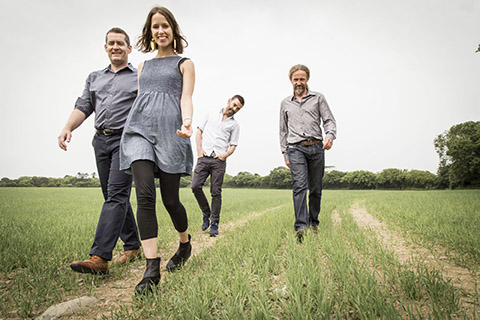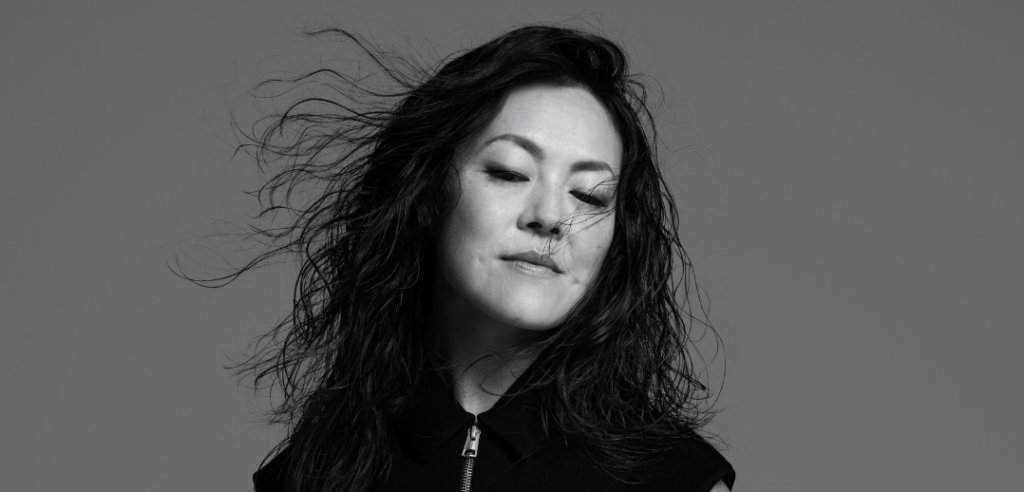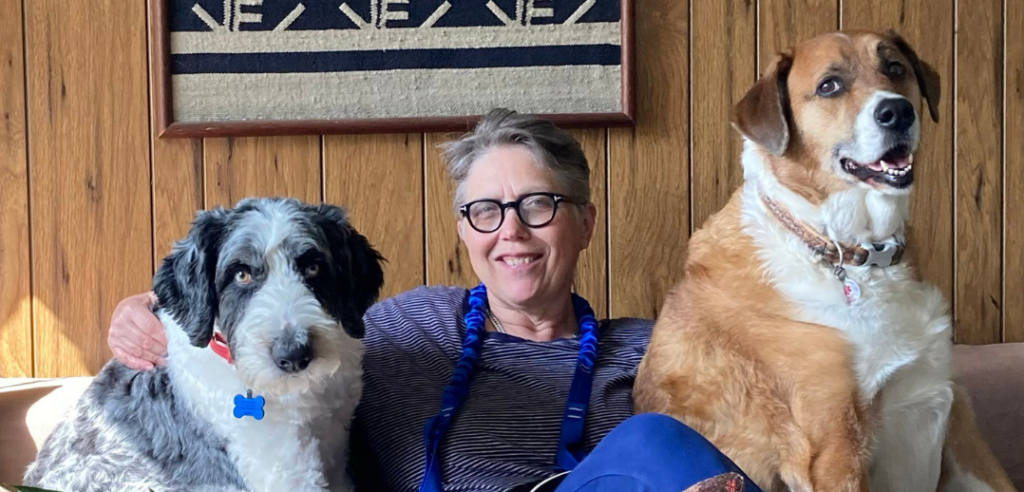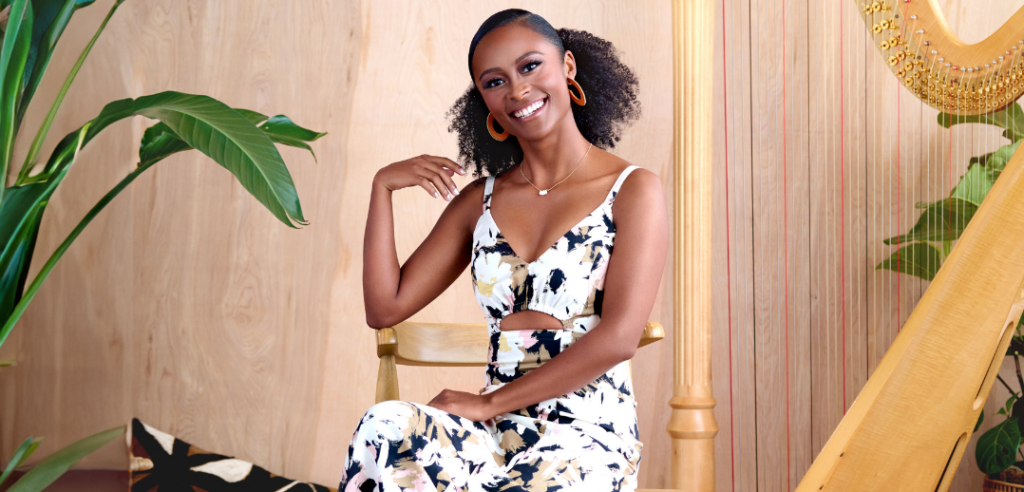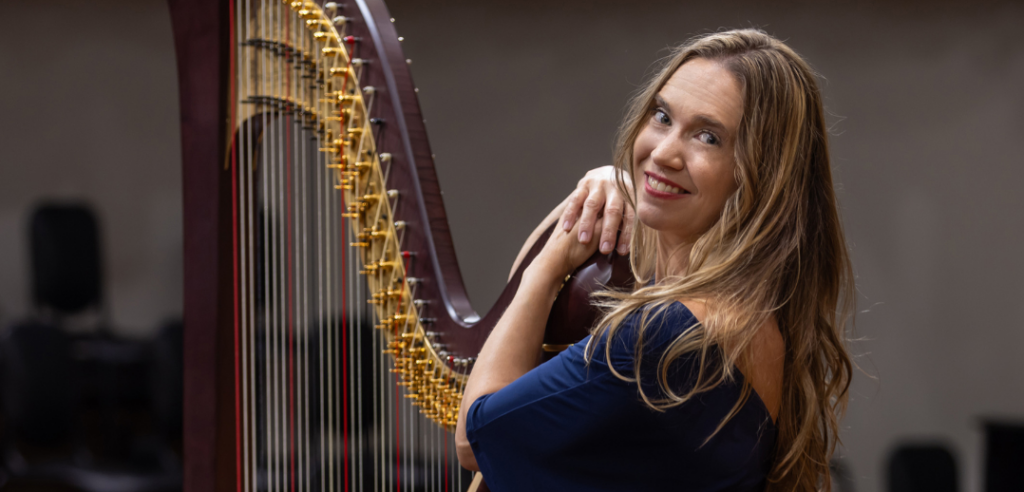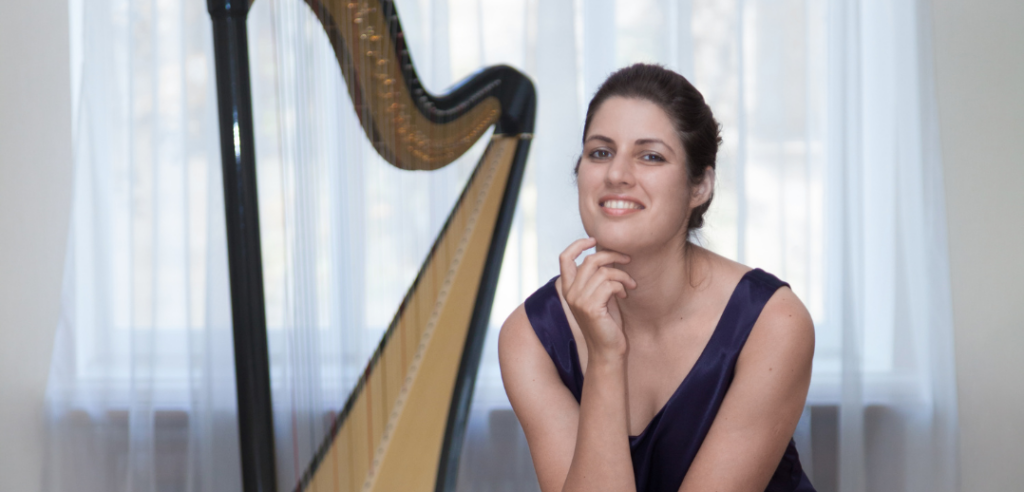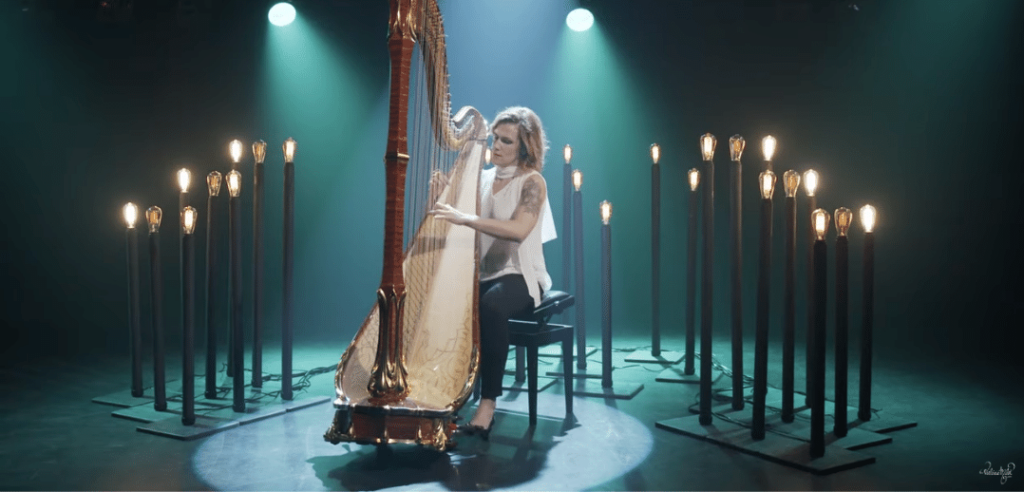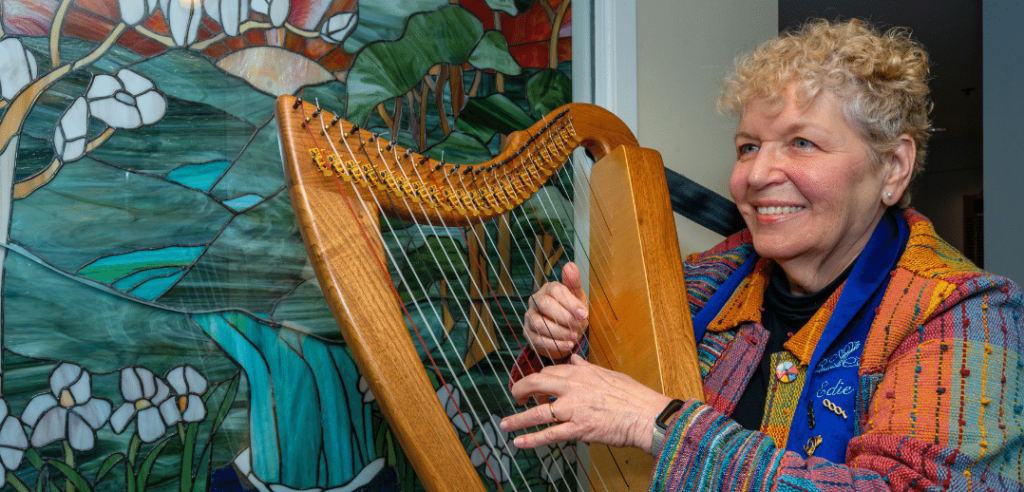When we first got to know Maeve Gilchrist back in 2007, she had just won the lever harp division of the Lyon & Healy Jazz and Pop Harp Competition. She was fresh out of Berklee College of Music in Boston and finding her way as a musical transplant from Scotland. Her musical creativity and originality blossomed over the last decade as she moved back and forth between New York City and Boston.
Today Gilchrist is fresh off premiering a concerto for harp and orchestra she was commissioned to write, along with composer Luke Benton. She also released a new album last month with bass player Viktor Krauss. Though Gilchrist has done much to validate the Irish harp as an instrument on par both technically and musically with its pedal counterpart, the idea that her instrument wouldn’t be taken as seriously is a foreign concept for Gilchrist, who grew up in a country with a rich and respected folk music tradition.
Perhaps the biggest step for Gilchrist and her Irish harp was her faculty appointment at her alma mater, Berklee College, which marked the first major college program to hire a strictly lever harp player on its faculty.
We asked New York harpist Brandee Younger to sit down with her friend and colleague for a conversation. This online version contains the full interview transcript.
Harp Column: Tell us about this concerto you just premiered.
Maeve Gilchrist: About three years ago I had just moved back to New York, and I got an email from a woman named Martha Hill in North Carolina. She was the director of the Western Piedmont Symphony at the time, which is a lovely symphony orchestra in Hickory, N.C. They seemed to have a focus on a lot of new works, and she asked if I would be interested in writing something for the orchestra. And I, with absolutely no experience writing symphonic music, said “Absolutely.” She suggested Luke Benton, a local composer who’d written and composed for the orchestra before as a co-writer on the project. It could have been a disaster, but turned out to be a really wonderful connection and experience. Luke and I started to meet up, and over the course of a year and a half we met five times either in Hickory or New York. A year and a half later, this concerto was born!
I was thinking about what I wanted to create a concerto with, from the rich color palette that a symphony has to offer, and what I could use as a vehicle for these rich sounds. And I thought back to the story of my great-great-grandmother, as written in a book by my mum called In Pursuit of Kate Corbitt. The short version of the epic story is she migrated from Georgian-era Dublin over to New York in the late 1800s, and two of her daughters died from diphtheria on the boat. They left Dublin because of limited work prospects in her husband’s civil service job as a Catholic. But when they came to New York, there was a lot of oppression against the Irish at the time. They moved West, taking advantage of homestead legislation and started a ranch in Casper, Wy., when it was really the wild, wild west. It was just a scattering of houses, and I just thought about the juxtaposition of their respectable urban Dublin living compared to the wilds of Wyoming, and the contrast of weathers and winters and work. But they managed it. Early on in their endeavors, their youngest son went back to Ireland and took over the family farm, and that’s her link to Ireland. After her husband had passed, she migrated back to England, where she became a Cistercian nun, taking a vow of silence. It’s an amazing story of an incredibly brave woman filled with beautiful, contrasting landscapes. Perfect fodder for a concerto!
HC: Now is this your maternal or paternal grandmother?
MG: This is my maternal grandmother. My mum had just written this book, and I thought it to be a perfect narrative. So we broke this concerto down to four movements: “The Voyage,” “New York,” “Wyoming,” and “Peace.” It was such a treat having such an array of colors to work with, and writing with Luke was fantastic. It was a real collaboration—not simply him orchestrating the themes I’d written. I was very involved in a lot of the orchestral part writing, and he was very involved in parts of the composition process as well as the the sourcing of material for last movement. We used some Gregorian chant themes for the “Peace” movement to reflect what she would have been hearing in the convent. It was a great partnership, and we premiered the piece last Saturday.
It was such a memorable night—a real thrill to hear it come to life! Totally terrifying—I’d never memorized such a long piece.
HC: It does make a huge difference to the audience though, to have your music internalized and avoid your face being buried in a stand.
MG: Yeah, though I did end up using a music stand just to be on the same page as the orchestra. It being a new piece and all.
HC: It’s a lot to perform a new concerto. It’s not like performing standard repertoire, where it has been played and recorded countless times and the string players know it, so you can just do whatever.
MG: Yeah.
HC: Do you plan on publishing it?
MG: Yes, and we’re going to publish a version for both lever and pedal harp. We’re currently working on a couple revisions.
HC: That was my next question! You obviously performed this on lever harp, so there will also be a version for pedal harp, that’s awesome. Did you record it?
MG: There will be a rough audio recording available pretty soon.
HC: I can imagine that there’s a lot of lever flipping.
MG: There is quite a lot of lever flipping! I wanted to create a piece that was reflective of all of the geographical influences. So there’s certainly some traditional Irish elements in there, but I also wanted to create a challenging, contemporary piece of harp music. There’s almost no repertoire out there for lever harp. There’s little enough for pedal harp, but almost none for lever harp. I believe the lever harp should be able to have a place living in harmony with the orchestral world, and I hope this piece has a life of its own.
HC: I think that’s extremely important. I have a student now who’s really struggling looking for a college, because at every school she visits with a harp program, the teachers imply that she’s not a serious harpist if she’s not playing pedal harp and tell her that she will have to switch to the pedal harp. She comes back to her lessons so broken, and I just try to continuously build her up and expand her lever harp repertoire.
MG: Well it’s particularly hard for lever harpists in North America, as there’s no existing folk harp tradition of any kind. Where I come from, there’s a rich tradition of folk harp, and people know what it is as an instrument. I’ll get into a taxi cab and the driver will say “that’s an Irish harp.” In Scotland I grew up calling it the clarsach. The rich harping tradition at home means there’s an existing repertoire, loads of young students, and the standard is very high. In South America it’s similar—Venezuela, Colombia, Paraguay—there’s a repertoire, there’s context. But over here there is no context for a folk harp scene apart from one that’s been created by enthusiasts. And I’m certainly not dismissing that. I can’t tell you how wonderful and generous the folk-harp community is over here—they’re such a gracious, amazing bunch of folk that have formed something really special. But it’s a much newer scene and is driven primarily by amateur enthusiasts. There’s a lot to be done in regards to the illumination of the lever harp as its own voice on the main stage. There’s a lot to be done, and is being done, to illuminate the harp in general! To raise both the visibility and standard of harping in both pedal and lever harp worlds so it can become a more dominant voice in contemporary music.
HC: Right, I think that what you’re doing is really important for the future of the instrument and its perception over here. It’s huge actually. Okay, so when the Harp Column interviewed you a decade ago—boy, time flies—you had just moved here to New York, and you said you thought it would take time to establish a career here. How do you think it’s going? What do you like about being a musician here, and what are the biggest challenges?
MG: It takes a lot of time to settle in New York City, but I absolutely love it! This is actually the second time I’ve lived here—I’ve been back about five years. Interestingly enough it’s been a very different experience compared to when I first moved to New York City in 2009.
HC: And this was after school?
MG: Yes, after a couple years in New York City, I came back to Boston. I was trying to decide between New York and Boston and just felt that it was a softer landing. Also with Boston for a time, and still really but especially for four years, it was such an explosion of the progressive string world and the new acoustic scene. So it seemed kind of natural for me to go there. But I moved back to New York about three years ago, and I absolutely love it now. I think it was an easier experience because I wasn’t reliant on New York to make my living. Which was huge because I know it can be such a hustle. Being able to come home and enjoy the city for all its artistic and social riches is amazing. The level of musicianship is continually inspiring and challenging, and the wealth of musicians to play with is incredible. There seems to be a unique focus on creating for creation’s sake—I’m spoiled with the players around and the breadth of vision.
HC: Right, which is very true. You said you went to Boston and came back here to New York, and you said it was different from the first time. What made it different? Is it because you had time to craft your career in between?
MG: Yes, it’s because I had those six years in between. When I moved, literally I don’t even think I was 21 yet. I finished my last day of classes and hired a moving van, and I moved by myself to a basement in Astoria.
HC: Wow, that’s hardcore.
MG: It was kind of the “small fish in a big pond,” on steroids! I was so lucky at Berklee (College of Music in Boston) because I had complete financial support. When you get that at 17, you don’t learn to budget. You know just like regular life, you don’t learn to budget.
HC: It’s sort of like just being thrown into the ocean, not knowing how to swim.
MG: Yes! I remember my poor mum coming to visit me and realizing my situation. I had no money and not the first clue of how to get a job or nail an interview. She must have been terrified, but in true mum fashion she made flyers and handed them around every hotel in New York City! She prepped me for my teaching interviews and taught me how to budget. I’m so grateful to her!
HC: Aww.
MG: Yes. She was so strong at a time when I was pretty weak. So then I started teaching general music up, not far from here, on 125th Street in Harlem. I was terrified! Those poor kids were probably given a very questionable curriculum. But it was a great experience, and I taught there for about eight months before my freelance work as a harpist started to pick up.
I think first of all in the harp scene, I started doing more harp festivals and the odd workshop here and there, and I’m so grateful to that community for giving me the work at a time when I really needed it. And then it kind of went on. When I moved back to Boston, I got hired by the great American bluegrass fiddler Darol Anger. He’s a great musician in the progressive American and Bluegrass scene, and he kind of introduced me to this whole world of other musicians, which has helped me with making my way into that scene. From there, when I came back to New York, I continued teaching at the Berklee College of Music. I tour with a number of projects—a percussive dancer called Nic Gareiss, The Nashville based bass player Viktor Krauss, guitarist Nir Felder. I do a fair amount of session work in the city and more recently the composing work and arranging have become a bigger part of what I do. I’m still swinging back and forth between the progressive folk worlds, and the more improvised-based music.
HC: Interesting, so you are doing a lot of sideman work—sidewoman work?
MG: Sidewoman work, yeah. More of a mouthful!
HC: Do you think that your sideman work is important? Does it really serve you as a musician? Do you feel that it helps you grow as an artist?
MG: Oh yeah, totally. For a few years before that, right after college I’d kind of throw myself blindly into booking tours, but I’d never given thought to what I actually wanted my music to be. I was cobbling together a repertoire drawing on my own traditional music and the different things I was hearing at Berklee and I had never thought about sound and cohesion of sound. So when I moved back to Boston I consciously stopped playing shows under my own name for the next five, six years. I did one solo project where I wrote a suite of compositions called the Ostinato Project, which was kind of a composition self-assignment to really challenge my hands as two separate instruments. But other than that, I decided I just wanted to break for a while as I decided what I want my sound to be. And I’m still kind of on that break. I have loads of duo projects, which are partly mine, but I’ve still not felt like taking the leap with having the “Maeve Gilchrist Band.” In the meantime I’ve just been so lucky to work with so many incredible musicians, and having to find space in those musical situations for myself has been key in how I play. It’s been so important in getting my rhythmic chops together, and improving my listening skills.
HC: I think it’ s important. When I had first finished college, a drummer buddy of mine that I work with a lot said, “ I think the key to being a good leader is being a good sideman.” That resonated with me. So I think it’ s beneficial to just work in as many different ensembles as you can, because it helps you not only musically get yourself together and get your music the way you want it, and get your sound the way you want it. But it also helps you in just literally leading a band. You know these are grown men and women that you’ re leading on the road, even in one-offs, it’ s a lot of work. It’ s not just go and play and lead. It takes epic leadership skills.
MG:: I feel like I was spending a lot of time working around the clock to learn practically unplayable music. I was so anxious to prove the versatility of the instrument that I got more caught up in the “ challenge” and less engaged in how to make the instrument sound great or, very likely, the musical setting into which it’ s becoming a part. The last few years as a sideman has really taught me to find my own voice. To speak up and say, “ Listen, I’ m going to sound terrible soloing over this. But if you could extend that section by four bars, I could create something worth something.” To find a way to interact with other musicians and composers and still ground myself in my own voice. That will all play heavily into how I work as a leader.
HC: Yes! And even how to just handle those situations and not come in. There was an instance where a composer friend & colleague of mine wrote a piece— an arrangement for a major symphony—and I actually helped him with the original arrangement, which was just with a vocalist & rhythm section. But he orchestrated it, and he said the harpist came up to him and said “ I can’ t play this,” instead of saying what you just said…what you just offered; “ This isn’ t going to work, these pedals are crazy. However…this or that will work” You’ re offering an alternative.
MG:: And educating them! That’ s the thing.
HC: Right! I think a lot of composers get scared. They’ re scared to write for us because often times our initial reaction is “ No, I’ m not playing this. I can’ t play this. Too many pedals, I’ m not a piano player. Too many notes. Too many repeated notes for this to work!”
MG: Or not enough. Like really, you want me to play four note chords in each hand? Whole notes for the whole piece?
HC: Yes! And then there’ s “ well when I was in school, I was taught to make sure you had ample space to change your pedals.” I was like “ you really took it to heart.”
MG:(That’ s the double edge.)
HC: Seriously.
MG: And it’ s important to remember that most people are open to interpretations. Like, when I give a fiddler player a part or horn player a part, I’ ll say, “ please make it sound good. If it doesn’ t sound good, change it accordingly.” If people aren’ t interested in learning about the instrument in a way that will benefit all parties—well, I’ m not sure they’ re someone I’ m interested in collaborating with.
HC: Well exactly, but in classical music these part are written and we’ re taught to play them as is. It was a rude awakening for me finishing school. Undergraduate school, and getting out in the real world and people giving me these parts. I’ m playing them verbatim and they’ re asking “ could you do something with it? Could you make it sound good?” So I really struggled, I had to really start to develop something on my own to try to accommodate everybody’ s music.
MG: How did you do that?
HC: I had to just do what you said earlier and sometimes you fall flat on your face to achieve some kind of goal. But I had to embarrass myself quite a few times in order to loosen up and eventually began to develop and apply my own style. I had to just become as creative as I could.
HC: Speaking of one’s own style, you have a new album coming out? Can you tell us about that?
MG: I do. It’s very much a duo project. I seem to have a plethora of duo projects!
This one is with a great bass player from Nashville named Viktor Krauss. I met him about two years ago at the Berklee Americana festival. Everyone flies in to teach, and there’s a faculty concert, and it’s this mad rush of everyone trying to learn everyone’s tunes in like 15 minutes! He had me on his tunes, and I had him on mine, and it was really fun. I’ve been a fan of his playing and composition for ages. I’d first heard him playing with Bill Frisell and then started exploring his own music on Nonesuch Records. His sense of space and his tone—I just remember seeing him play live once, and he had a tuner in front of him, and he was watching the tuner the whole time as he played.
And playing with him—a lot of his tunes are really slow tempos, but it’s so easy to play with him at those tempos because he makes it feel so full. Not that he’s playing a lot, but his tone and his placement just make it real easy to groove at that speed.
HC: And that’s not easy for harpists because we can’t sustain. The struggle to sustain is real.
MG: Yeah. And often it’s hard for people to play with us because they’re not used to that either. To feel our time.
HC: Time. That’s the number one complaint I hear from composers and bandleaders about harpists.
MG: Yes. And as harpists we really have no excuse! We may have some harmonic limitations—but our sense of time and rhythm should be as good as anyone’s.
HC: I read an interview that Adele Girard, did and she complained about getting heckled for having bad timing. It was in a big band setting, and she was saying, “We have all of these pedals to deal with,” and this, that and the other. Our attack is so deliberate. We’re not hitting a key that’s then hitting a hammer. There’s always something in between your attack and the instrument’s…
MG: …sound.
HC: Yes, the actual sound. It can sneak up on you—and I’ve always had great internal timing, so I could always hear on the outside when I was ahead of the beat.
MG: Is that your tendency? Or was that your tendency?
HC: Yes, it was definitely my tendency. I realized early on that in studying classical music, we’re always a bit on top of the beat.
MG: On top of the conductor as well, right?
HC: On top, on top, on top. And in other settings, whether it’s jazz or even some popular styles, you’re sort of sitting behind the beat. I do think that there is right in between on top and behind, and it took me playing behind a lot, intentionally, countering my natural tendency, to help settle on the actual beat.
MG: That’s so interesting. I feel like I’ve taken the exact same journey. Growing up playing Scottish and Irish music, I grew up stamping my foot and flying on the edge of the beat. It’s just part of the tradition. And so when I started getting more involved in improvised music and jazz, I really had to work on laying back.
But when I started to get more into classic jazz—again, same as you, I was hearing how I needed to lay back on the beat. So I did, and I really overcompensated to the point where I felt like I started to drag in situations. And it was then that I started to think of the beat as more of a spectrum, allowing an elasticity to time that was going to be slightly different in whatever musical setting I was in. So now it’s not about knowing if the beat is ahead or behind, but it’s much more about using my ears in the moment to work out where we are rhythmically and find my place in that. I think there’s such a beauty to that. A living and breathing sense of time.
HC: Yes! And that’s the way a listener wants to hear it.
MG: Despite my love of jazz and my ventures into the world, I still hesitate to call myself a jazz musician. I certainly use elements of jazz—the harmony, the investigative improvisation, and the imaginative approach to time and melody—but I am not well versed enough in the history and vocabulary to identify as a jazz musician. I’ve spent a lot more time in the folk worlds and the progressive acoustic music scene.
HC: That makes perfect sense, and people always want to place you in some kind of box and to always apply a label. So, in playing slowly on your new record…
MG: [Viktor and I] kept in touch for a couple of years. Also I was getting more interested in electronics, and the augmentation of acoustic sounds. And Viktor—you know, he’s best known for his work as an acoustic bassist, but he’s got a degree in electronic music, and he’s got a crazy collection of vintage synths and pedals.
HC: So is this record going to be electronic?
MG: There’s definitely going to be electronic elements, but in a very organic way, more of an extension of what’s already going on. When we started corresponding, I asked the label I worked with [Adventure Music Records] if they would be interested in making and releasing the record. They kindly and blindly said yes. We didn’t know what we were going to record, and we pretty much wrote a whole album via email. It’s instrumental, it’s quite cinematic and textural. A lot of slow grooves. It’s essentially a duo record, but we both play a lot of things, again, just subtly augmenting the presence of the harp and bass. I double a lot of my harp lines on vintage synths and Wurlitzer. He plays the guitar and a whole ton of other instruments—he’s a wizard! We used an old analog Roland rhythm composer drum machine on one track, which worked beautifully and had an organic human element because of the slightly inaccurate analog pulse!
HC: Is it self-released or on a label?
MG: It’s getting released on Adventure Music Records on April 21.
HC: Looking forward to it! You became the first lever harp teacher to be hired at Berklee. And to our knowledge, you’re the only strictly lever harp player to teach at any major music college in the U.S. What has that experience been like? Do you feel any sense of responsibility or pressure being the first in something?
MG: When I was hired to teach at Berklee, I was really surprised. I would never have dreamed of seeking out that position still being so young. But I knew it was a great opportunity, and it has been. I’m sure you know, teaching is such an amazing way of learning how you want to play and what you want to focus on. The harp department is really rich right now, showcasing an incredibly diverse array of harping styles. We had the first harpist in the global jazz institute.
HC: Yes, Charles Overton. He’s great.
MG: Oh isn’t he just amazing? So, we have some fantastic jazz players interested in finding a place for the harp in the jazz world. And there are some great singers and songwriters and accompanists. There’s a great harpist [Mairi Chaimbeul] who graduated about a year and a half ago. She’s really a great pedal harpist as well. She mainly plays lever harp now, and she’s also kind of found her way into the new acoustic scene. There’s a great Colombian harpist called Nicholas Castaneda. It’s so exciting as a harpist right now, like a different world from when I was there, just in regards to stylistic diversity. It’s so exciting for me to be in this nest of great players and be able to share what I do and have them share back!
HC: Right. It’s incredible that there is a program like that. Because so many schools have a very, very traditional curriculum, but this approach really speaks to the state of music in the world once one is out of school.
MG: It really is wonderful. There are too many unimaginative harp programs in the world providing limited options for our harpists. When you asked if I felt a responsibility—yes, I really feel a responsibility because I know how important Berklee is as a relevant 21st century institution. I want it to be the best education a harpist can have, and I know that the argument is often that when a curriculum focuses on “style” studies, the technical studies lose credibility. I don’t feel it has to be this way. I think our harpists are entitled to a great technical education and should also be provided with skills that will help them go out there and create a career for themselves. And by that I mean versatility—harmony skills, improvisation skills, arranging skills, and most importantly a real love of music and attitude that says, I can do anything with this instrument! I know my [Berklee] colleague Felice Pomeranz shares that vision, and we’re hugely excited about the growth of the department.
Something I’m particularly passionate about is helping students find their way in ensemble situations. How to use their skills and their ears to find a musical place for themselves in group situations.
HC: Which is something that every harpist—every musician—will have to do.
MG: Yeah, why be a musician if you can’t converse? Conversation is one of the most exciting experiences you can have as a musician. To create and wind in and out and add to music in the moment—it’s just the best! For some reason it seems to be really tricky for harpists, particularly coming out of classical backgrounds, to move away from the page and figure out what to play.
HC: Right, right. Back in 2007, fresh out of college, you said you really didn’t think of your musical style as being one thing or another, but you just wanted to try and be a tasteful musician in whatever circumstance you found yourself. Do you feel like you’ve settled into any style? Or are you still a musician who can step into any number of styles and make great music?
MG: Well, I hope that in these past ten years—I can’t believe it’s been ten years— I hope most of all that I know myself as a musician better. So I’ll happily step into a number of different musical situations, and I thrive on the diversity, but I feel a lot more able to present myself musically now and do know what I can offer.
HC: That’s a good answer. Having been away from your native Scotland for a while now, how do you stay connected with your family and your roots there?
MG: That’s a great question. I grew up in Scotland. My dad’s Scottish, but my mother’s Irish. And I’m sure I told them this back in 2007, but my mother’s really the harp connection. Two of my aunts are professional harpists, my cousins are harpists. My Irish side is full of music in both traditional Irish music and classical music. But it took me coming to America to really explore my Irish traditional roots. And that’s just because America, particularly Boston, New York, and Chicago, has such roots in Irish music, especially in the last hundred years. In the 1930s when there were waves of Irish immigrants coming over here, it was right when the recording industries in America were starting to blossom. All of the big labels in the early 1900s were recording Irish artists, and those records would move to Ireland in becoming the first recordings of Irish music. And so I think I think that’s important for Americans wanting to learn Irish music to know because it validates this as a parallel scene and not an imitation scene in the last hundred years.
Something I’m particularly passionate about is helping students find their way in ensemble situations—how to use their skills and their ears to find a musical place for themselves…
But also because I was coming to it more as a student, I fell in love with Irish music all over again when I moved to America. That’s when I really got into the old recordings and started appreciating the unique nuances of the groove and the tonality. I love Irish music, and so I’ve been delighted to see that in the last few years there seems to be a real curiosity springing up in Ireland between the traditional music scene and the more progressive musicians. They have been deconstructing old tunes in an interesting way, infusing breath and making space for improvisation. With regards to my professional life, I find the scene over there very inspiring, and I tend to go to Ireland a lot more than I go to Scotland. I’m involved in the scene there, and I have commissions in progress there. My instrument is such an important icon of the country, do you know what I mean? I love that when I go over there, I don’t have to explain myself. I just have to play music.
HC: Because it’s normal?
MG: Yes, because it’s normal. Yeah, it really is such a gift. I also love that when I teach with the college systems, it’s almost always young players. Don’t get me wrong, I absolutely love my mature students.
HC: They’re adults that started the harp later on in life.
MG: Yeah, and it’s so wonderful, but it’s so refreshing to go to harp festival and have 35 under-16s in my class.
HC: That’s because, here in America, they start children off learning classical studies, and that’s it.
MG: Of course, and there’s no reason they wouldn’t. Because it’s not a tradition here, and there’s no bluegrass harping tradition, or an Americana, or Appalachian harping tradition. There isn’t, you know?
HC: Yeah, I never really thought about that.
MG: There’ s not a blues harp tradition. Right? Like there’ s – is there? Is there a ragtime harp tradition? Or like, what would be the equivalent American roots tradition?
HC: Right. What’ s American? For harp? I’ m not sure. Mostly European – Irish harp, African harp. I’ m starting to see more African harp incorporated in the harp world.
MG: Really? Right, do you start to see the subtle influence of it in the music?
HC: No, Not the influence but it being recognized, I guess, like at conferences. A little bit, you know? There’ s always the people that you hear…
MG: You mean like the kora being recognized in music, right? It becoming more hip in the music scene?
HC: Yes, exactly. I was really happy to see the kora being incorporated in some recent harp events, and of course when I meet people at church they’ re like “ oh King David. David play on your harp” You know? That’ s all they know!
MG: I never heard of that till I moved to America. I had to like research!
HC: Because if you studied the bible, you know that David had his little harp. It had just a few strings.
MG: It’ s funny because Joel Harrison, a great New York City guitarist who wrote the press release for the new record. The first thing he said was “ it sounds so kora-like. I think he must have been referring to the first track which is 12/8. I’ m a huge fan of Kora music. I love the tumbling approach to improvisation and the rhythmic engine on which it’ s based. So I’ m sure I’ m unconsciously channeling my inner kora player at times – though it’ s important to remember that there are a lot of 6/8 and 9/8 rhythms in Scottish and Irish music as well.
MG: But it’ s true that I love kora music, and I love – there’ s the tumbling, cascading approach to improvisation is so unique.
HC: Alright so, you told us 10 years ago that you believe the harp can go anywhere. And you’ve certainly taken the lever harp to new places both literally—to the faculty of Berklee, to a solo concerto with a classical symphony orchestra—and figuratively in terms of the fusion of musical styles you do so well with the harp. So where do you want to take the harp in the next 10 years?
MG: Oh gosh, if I can keep rolling in the same direction, and if I can keep working with the musicians that I work with or aspire to work with, I feel like I’ll constantly be growing. In the last two years, with the concerto commission and a couple of other commissions, I’ve really got the composing bug.
HC: Do you compose on the harp or on the piano?
MG: Both. With the concerto I did a lot of the harp things on the harp, obviously, because I was playing around with extended techniques and effects on the instrument. But a lot of the part writing I did at the piano.
I just love music. As I listen to music, with every new sound I hear I’ll think, god, how could I apply that to my instrument? How could I fit into there musically and find a place for myself? Isn’t that simple thing the cello’s playing so beautiful? How can I emulate that? As I get more into synths and also electronics, how can I tastefully augment the soundscape? I was at the Guggenheim yesterday, and as I was looking at these amazing pictures, it was the detail and the surprise in parts of them that I was drawn to. It’s the same across the board with all the arts.
You know, we were just saying how funny it is to look back 10 years and think how much we’ve evolved—or not evolved. But as I say, for example as Viktor and I are finishing this recording, what we’ve achieved just feels like a happy celebration of the initial meeting. We both feel like the real work is going to get done in the future.
My mum and I road-tripped back from the concerto concert, and we stopped at Frank Lloyd Wright’s Fallingwater in Pennsylvania. Fallingwater is his incredible house built out of a waterfall, super integrated with the natural flow of the land.
HC: You posted a picture on Instagram.
MG: Yes, exactly. It’s so beautiful, and the guy was telling us that when Frank Lloyd Wright was asked, “What’s the best work you’ve ever done?” He would always say, “The next work will be the best.” I thought that was so great, and it’s just a testament to development and never quenching the creative fire of your spirit.
HC: What would you be if you weren’ t a harpist?
MG: Well, I love lots of things, but I’ m not necessarily very good at them. So I could be a very unsuccessful artist, or fashion designer. Or you know, I feel like everyone at the age of 14 is like ‘ I’ m going to be a fashion designer.’ I remember actually when – before I went to Berklee I was at a music school. It was a wonderful, council funded music school called the City of Edinburgh music school. Which was an amazing facility that was totally free. I also auditioned for St. Mary’ s, which is a more kind of classical-based public school, which means private school in America. And I remember it was this intimidating board, and my mum said she went in [with] me for the audition, and I’ d passed all of the musical tests. They all said, “ What you want to do for a living, Maeve?” I was 9 and a half, and I said, “ I want to be a model for hats.”
HC: Okay, a hat model.
MG: My mum was like, “ nice one!” Amazingly I got accepted but ended up going to the City of Edinburgh Music School. I liked the environment more; it was what I was used to. It is amazing. I always loved clothing, textiles especially. I got into silk painting for a while. I also love writing and words. So I would do something creative.
HC: What’ s the last album or song that you brought?
MG: A couple of things— I brought this album called Woman, by this singer called Rhye. It’ s from 2013 and it’ s electronic music. And it’ s because my friend Julia, who’ s a great singer [and] songwriter, sent it to me. It begins with this kind of psychedelic pop harp crescendo, but it’ s a guy singing, and it’ s this like amazing harp-ish vibes. I’ ll just wait until the vocals come in. It’ s a really beautiful album. I also got Empyrean Atlas? They’ re a Brooklyn-based band. They’ re great. This first track is great.
HC: Can I see the album? Everyone’ s got these cool band names.
MG: Actually, you can hear the kora influence in this. You can just listen to this timbre of the guitar playing. But I love this—I’ m such a nerd in regards to part-writing in music. The machine, I get real satisfaction from this machine-like approach to parts that click into one another. And yeah, I’ve heard that first track and really love the band. Those were the two last purchases.
HC: Cool. Both sounded interesting. So, how much teaching do you do these days? What is one piece of advice you would give to students who are inspired by what you’ve done with the harp and want to follow in your footsteps?
MG: Right now I teach a day a week at the Berklee College of Music. I have the occasional private student in New York, but really just two. I have a couple of Skype students as well, so I have [a] kind of very small group of private students, and it’ s mainly Berklee. I’ve been doing this online thing called Harp Talk once a month, which started out as just a really informal —it’ s still really informal—but kinda discussion and workshop for harp. Simply because when I was teaching at all these harp festivals and workshops, often you get people flying in from states where there were no harp teachers. Or there is no harp community, and no way for them to continue their studies or even ask questions. But the same people started coming back and now there’ s this really loyal kind of crew of 30. I do a lot of workshop teaching and the occasional festival and camps. I love it, I mean teaching has been hugely instrumental in my development as a musician.
HC: Ten years ago you won the Lyon & Healy Jazz and Pop competition for lever harp. Since then you’ve moved mountains with the harp and brought not just the harp into new places, but specifically the lever harp. I personally feel that you’re giving the lever harp credibility that it didn’t necessarily have here in the States. That said, thank you so much for your contribution. Thank you, Scotland, for sharing Maeve with us. What is your vision for the harp in general? What is your vision for the future of the harp in general? Not just lever harp, but large scale?
MG: That’s so kind of you, and thank you. I’m really grateful that I picked up the harp when I was 9 because it’s been my vehicle to so much of the world, and it’s been my access pass to so many musicians I probably wouldn’t have had access to otherwise. When I think of music, I don’t think of just my harp. The harp is my vehicle to make music with other people, and I’m sure whatever I played, I would’ve tried to pursue it the same way.
I would love for all other harpists to have the same experience that I’ve had, and that means cultivating a real curiosity and love for music and making music. Ultimately, what that will take is an opening up of the greater harp world and an active approach to integrating the harp into different musical situations. It’s being open to style studies and improv studies and integration studies. Those are disciplines in themselves, but I think sometimes there’s a fear from classical institutions of losing their technical focus. The idea that refocusing the direction and aesthetic of the harp will somehow dilute the technical abilities of the instrument is nonsense, but a lot of existing harp curricula are very rigid in their approach to the instrument. I guess I’m thinking of primarily the classical harp now. I realize I’m living in a country where the most technically proficient players are coming out of classical institutions, but that’s simply because, as we said before, there’s not a folk harp tradition. That’s changing, and people seem dedicated to that change which is great. But it’s simply as it is right now.
Most of the technically skilled students I’m working with are coming from classical backgrounds. Wouldn’t it be wonderful if they could take these technical skills and apply them to other musical worlds? They could enjoy conversing and creating with other instruments, and not feel like they’re entering those worlds at a lesser or more fearful place. To do that, they need to really know their theory, they need to have real rhythmic stability. That stuff simply isn’t included in classical curricula today. So if I could do anything, it would be to push for more musical general knowledge in the harpist education. That will give them access to the greater world of music, and we all know that there are fewer jobs for classical musicians out there. There aren’t that many jobs for folk musicians or jazz musicians, but if you can become as versatile and open and skilled—all three of those things—as you can, there’s much more likelihood that you can make a living as a musician, and that you’ll also gain satisfaction and joy from your music. •







